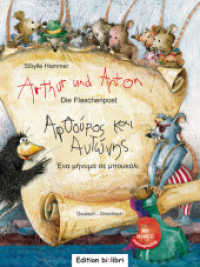- ホーム
- > 洋書
- > 英文書
- > Business / Economics
Full Description
This book bringstogether leading experts to assess how and whether the Nazis were successful infostering collaboration to secure the resources they required during World WarII. These studies of the occupation regimes in Norway and Western Europe revealthat the Nazis developed highly sophisticated instruments of exploitationbeyond oppression and looting. The authors highlight that in comparison to theheavy manufacturing industries of Western Europe, Norway could provide many rawmaterials that the German war machine desperately needed, such as aluminium,nickel, molybdenum and fish. These chapters demonstrate that the Nazis providedincentives to foster economic collaboration, hoping that these would make everymine, factory and smelter produce at its highest level of capacity. All readerswill learn about the unique part of Norwegian economic collaboration duringthis period and discover the rich context of economic collaboration acrossEurope during World War II.
Contents
SectionI. The German Demand for Norwegian Resources.- Chapter1. Ideology and Business Strategy: Assessing Nazi Germany's differentapproaches to the supply of light metals for the Luftwaffe; Lutz Budrass.-Chapter 2. Frozenfillets from the far north: German demand for Norwegian fish; Ole Sparenberg.- Section II. The Western European context: Regulation and Responses.- Chapter 3. Financial andmonetary developments in the occupied Netherlands, 1940-45; Hein A.M. Klemann.-Chapter 4. Doing business with the Hun: Dutch business during the Germanoccupation 1940-1945; Martijn Lak.- Chapter 5. Seizureor Purchase? French deliveries for German purposes in World War II (1940-1944); MarcelBoldorf.- Chapter6. Shades of Collaboration: The French Automobile Industry under GermanOccupation, 1940-1944; Talbot Imlay.- Chapter 7. A Faustian Bargain: Denmark's precarious deal withthe German war economy; JoachimLund.- Chapter 8. Corporatistinstitutions and economic collaboration in occupied Belgium; Dirk Luyten.-Section III. Supply: Managing and extracting resources from the Norwegianeconomy.- Chapter 9. Incentive structures and state regulations of theNorwegian economy; Harald Espeli.- Chapter 10. Why Germany did not fullyexploit nickel industry in occupied Norway: IG Farben and the political economyof nickel in the Third Reich; Pal Sandvik and Jonas Scherner.- Chapter 11. A quest for diversification?Norsk Hydro, IG Farben and the German light metal program; Ketil Gjolme Andersen and Anette Storeide.- Chapter12. Facingdisincentives: Norwegian aluminium companies working for the German aircraftindustry; Hans Otto Froland.- Chapter 13. Hitler's Achilles Heel: The contestfor the Norwegian Molybdenum supply; Andreas Dugstad & Mats Ingulstad.-Chapter 14. The Norwegian fishing sector during the Germanoccupation-continuity or change?; Bjorn Petter Finstad.






